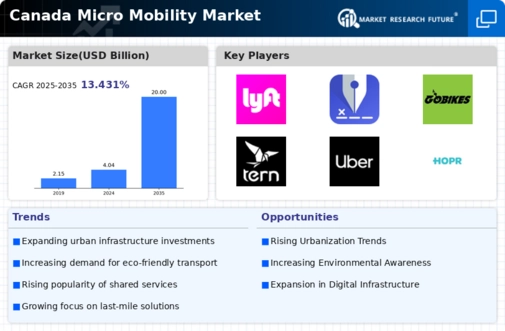Urbanization and Population Density
The increasing urbanization in Canada is a pivotal driver for the micro mobility market. As cities expand and population density rises, traditional transportation systems face challenges in accommodating the growing number of commuters. In urban areas, the demand for efficient, flexible, and eco-friendly transportation options is surging. Micro mobility solutions, such as e-scooters and bike-sharing programs, offer a practical alternative for short-distance travel. According to recent data, urban areas in Canada are projected to see a population increase of approximately 15% by 2030, further intensifying the need for innovative transportation solutions. This trend indicates a robust growth potential for the micro mobility market, as urban dwellers seek convenient and sustainable ways to navigate congested city streets.
Government Support and Policy Frameworks
Government initiatives and supportive policy frameworks are crucial drivers for the micro mobility market in Canada. Various municipalities are actively promoting micro mobility solutions through subsidies, grants, and infrastructure investments. For instance, cities like Toronto and Vancouver have implemented pilot programs to integrate e-scooters and bike-sharing systems into their transportation networks. These efforts are often backed by funding from federal and provincial governments, which recognize the environmental and economic benefits of micro mobility. The Canadian government has allocated over $300 million to enhance urban transit systems, which includes investments in micro mobility infrastructure. Such support not only encourages the adoption of micro mobility options but also fosters a favorable environment for market growth.
Technological Integration and Innovation
Technological advancements play a vital role in shaping the micro mobility market in Canada. The integration of smart technologies, such as mobile applications for ride-sharing and GPS tracking, enhances user experience and operational efficiency. Innovations in battery technology and vehicle design are also contributing to the growth of the market. For instance, the development of lightweight, durable materials for e-scooters and bikes is improving performance and safety. Furthermore, data analytics is being utilized to optimize fleet management and route planning, making micro mobility solutions more accessible and reliable. As technology continues to evolve, it is expected that the micro mobility market will witness increased investment and innovation, further solidifying its position within the broader transportation ecosystem.
Environmental Awareness and Sustainability
Growing environmental awareness among Canadians is significantly influencing the micro mobility market. As concerns about climate change and urban pollution escalate, consumers are increasingly seeking sustainable transportation alternatives. Micro mobility solutions, which typically produce lower emissions compared to traditional vehicles, align with the values of eco-conscious individuals. Recent surveys indicate that approximately 70% of Canadians are willing to consider using e-scooters or bicycles as a primary mode of transport to reduce their carbon footprint. This shift in consumer behavior is likely to drive demand for micro mobility services, as individuals prioritize environmentally friendly options. Consequently, the micro mobility market is positioned to benefit from this heightened focus on sustainability, potentially leading to increased adoption rates and market expansion.
Changing Consumer Preferences and Lifestyles
The evolving preferences and lifestyles of Canadians are driving the micro mobility market towards new heights. With a growing emphasis on convenience, flexibility, and health, many individuals are opting for micro mobility solutions as a viable alternative to traditional transportation. The rise of remote work and flexible schedules has led to an increase in short trips, which are ideally suited for e-scooters and bicycles. Additionally, the trend towards healthier living is prompting more Canadians to incorporate cycling and walking into their daily routines. Recent studies suggest that nearly 60% of urban residents are considering using micro mobility options for their daily commutes. This shift in consumer behavior indicates a promising outlook for the micro mobility market, as it adapts to meet the changing needs and preferences of the population.






















Leave a Comment